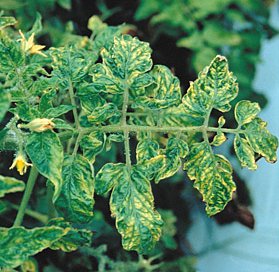Tomato mosaic virus (ToMV) is a member of family tobamoviridae and belongs to the genus tobamovirus, which is a plant pathogenic virus. It is found worldwide and affects tomatoes and many other wide host range plants including many agricultural crops and weeds such as tobacco and beans, all of which can serve as inoculum sources. The tomato crop is highly susceptible to the Tomato mosaic virus (ToMV). The symptoms vary from tiles, wrinkle, reduction and curvature of leaflets, and irregular ripening of fruits. This disease requires attention because of its easy dissemination by contact, cultural practices, or contaminated seed.
Structure of Tomato Mosaic Virus
ToMV has a rod shaped structure, about 300 nm length and 18 nm radius. ToMV has its genetic material enclosed in a protein coat. Tomato mosaic virus encodes four different proteins important for virus replication and movement, they are 180kDa /RNA dependent RNA polymerase, 130kDa/ Methyltransferase/Helicase, 30kDa/ Movement protein and 18kDa/Coat protein. The two proteins involved in replication are encoded by the genomic RNA where as the two involved in virus packaging and movement are translated by sub-genomic RNAs. The virus particles are very stable and remain infectious for many years after extraction.
Table 1. Different proteins encoded by tomato mosaic virus
| ORF | Function |
| 180kDa /RNA dependent RNA polymerase | Replication |
| 130kDa/ Methyltransferase/Helicase | Replication |
| 30kDa/ Movement protein | Cell to cell and long distance movement of virus particles |
| 18kDa/Coat protein | Packaging of viral RNA |
Symptoms of Tomato Mosaic Virus
Tomato mosaic virus symptoms can be found at any stage of growth and all parts of the plant may be infected. ToMV causes yellow mosaic symptoms on the leaves and tomato fruits. Tomato mosaic virus symptoms are seen as a general mottling or mosaic appearance on foliage. Light and darker green mosaic leaf mottle, sometimes with distortion of younger leaves; this is the most common reaction in summer in glasshouses. In winter, with low light intensity, short days and temperatures not above 20°C, plants are often severely stunted and leaves distorted to ‘fern-leaf’ or tendril shape, but mottling may be slight. Plants are less vigorous, and fruit yield is reduced by 3 to 23%. Tomato mosaic virus strains occur in Chenopodium murale in the USA, causing severe stunting, distortion and necrosis , and in pear associated with a diffuse chlorotic leaf spotting.

Detection of Tomato Mosaic Virus
Treating mosaic virus is difficult and there are no chemicl controls like there are for fungal diseases. Tomato mosaic virus has been found to survive for up to 50 years in desiccated plant detritus! So tomato mosaic virus control then leans less on eliminating the disease and more on reducing and eliminating the virus sources and insect infestations. Control is mainly based on the use of virus-free seeds.
For detection of the pathogen, different methods may be used, including molecular or biological, and the use of indicator plants. However, these methods require appropriate facilities and are time consuming. Furthermore, the existence of strains of Tobacco mosaic virus (TMV), Tobamovirus, may cause symptoms similar to those caused by ToMV, making the biological test more complex. When it comes to establishing the health of a seed lot, the use of indicator plants may be replaced by the monoclonal-ELISA test. The DAS-ELISA (double antibody sandwich Elisa) is a relatively sensitive technique and is widely used for preliminary identification and quantification of viruses in plants. The DAS-ELISA test on tomato seeds (ToMV Elisa Kit) was an efficient method for detection. Thermotherapy for 24 h was shown to be effective in eradicating the virus, and caused less damage to the seed physiological quality.
